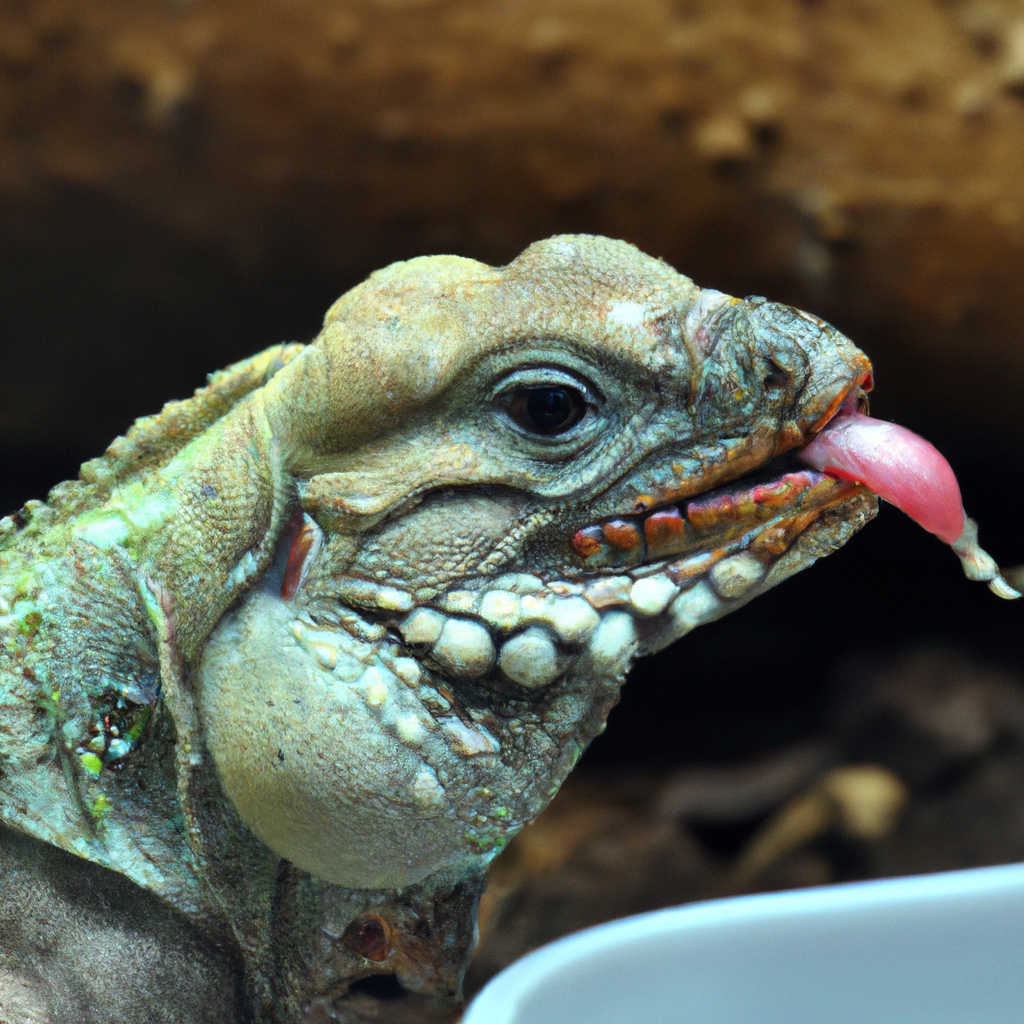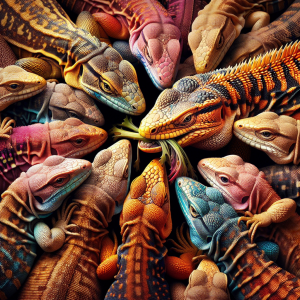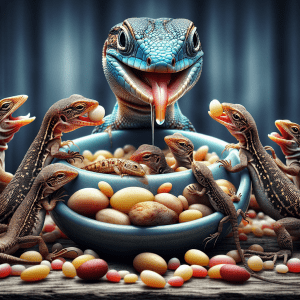Introduction to Lizard Feeding Schedules
Have you ever wondered about the eating habits of lizards in the wild? Well, here’s a fascinating tidbit for you: some lizard species are known to be opportunistic feeders, meaning they will consume food whenever it becomes available, rather than adhering to a strict schedule like our pet lizards at home.
It’s quite intriguing to think about how these wild lizards adapt to their environments and utilize different feeding strategies to survive. While our pet lizards may not have the same challenges as their wild counterparts, understanding their natural behaviors can still provide valuable insights into how we care for them in captivity.
By learning more about lizard feeding schedules, we can ensure that our scaly friends receive the proper nutrition and care they need to thrive in our homes. So, let’s dive into the world of lizard feeding routines and discover how we can create a healthy and balanced diet for our beloved reptilian companions.
Importance of Establishing a Feeding Routine
You know, setting up a feeding routine for your pet lizard may seem straightforward at first, but there are actually some challenges and controversies that come into play. One of the common dilemmas many lizard owners face is determining the right balance between providing enough food for their pet without overfeeding. It’s a fine line to walk because you want to ensure your lizard is well-nourished, but you also don’t want to risk causing obesity or health issues due to excessive feeding.
Another challenge is understanding the specific dietary requirements of different lizard species. Each type of lizard has its own unique nutritional needs, so it’s crucial to do your research and tailor the feeding schedule accordingly. For example, a herbivorous lizard will have a diet primarily consisting of vegetables and fruits, while a carnivorous lizard will need a diet rich in insects or small prey.
Controversies can arise when discussing the frequency of feedings and portion sizes. Some sources might recommend feeding your lizard daily, while others suggest a more spaced-out schedule. Similarly, opinions vary on how much food to offer in each feeding session, with factors like the lizard’s age, size, and activity level coming into play.
Navigating these challenges and controversies is all part of the journey to becoming a responsible lizard owner. By staying informed, seeking advice from reputable sources, and observing your lizard’s behavior and health, you can work towards establishing a feeding routine that meets your pet’s needs and keeps them happy and healthy. Remember, it’s all about finding the right balance and making adjustments as needed to ensure your lizard thrives in its environment.
Types of Food Suitable for Lizards
When it comes to feeding your pet lizard, choosing the right types of food is crucial for their health and well-being. Different lizard species have varying dietary requirements, so it’s essential to offer a balanced diet that meets their specific needs.
One practical tip to keep in mind when selecting food for your lizard is to opt for a variety of options. Lizards are known to enjoy a diverse range of foods, including live insects, vegetables, fruits, and even commercial reptile diets. By offering a mix of these food items, you can ensure that your lizard receives a well-rounded nutritional intake.
Another important consideration is the size of the food you provide. For smaller lizards, such as geckos, crickets and mealworms are popular choices due to their size and nutritional value. Larger lizards, like bearded dragons, may require larger prey items such as dubia roaches or even small mice.
It’s also worth noting that some lizards have specific dietary preferences or restrictions. For example, herbivorous lizards like iguanas primarily feed on plant matter, while insectivorous species like leopard geckos thrive on a diet of insects. Researching the dietary habits of your specific lizard species will help you tailor their feeding schedule accordingly.
By offering a variety of food options, considering the size of the food items, and understanding your lizard’s dietary preferences, you can create a feeding schedule that promotes their health and happiness. Remember, a well-fed lizard is a happy lizard!
Factors to Consider When Creating a Feeding Schedule
Hey there! Let’s dive into the nitty-gritty of creating a lizard feeding schedule! So, when it comes to figuring out the factors to consider for this feeding routine, it’s like planning a lizard’s version of a Michelin-starred meal plan.
Picture this: You’re the head chef, and your lizard is the discerning food critic. You want to make sure you’re serving up the best dishes to keep your scaly friend happy and healthy.
Now, here’s where it gets interesting. When brainstorming what to include in your lizard’s menu, think of it as a game of culinary Tetris. You need to find the right balance of nutrients, vitamins, and minerals to create a well-rounded meal. It’s like preparing a gourmet feast for a tiny, scaly gourmand!
And just like any top chef, portion control is key. You don’t want to overload your lizard with a buffet fit for a Komodo dragon. Remember, moderation is key – even for our tiny reptilian friends!
But hey, we all have our off days, right? Maybe you accidentally serve up a cricket too many or forget to include that side of leafy greens. Don’t worry – we’ve all been there. The important thing is to learn from these slip-ups and adjust your lizard feeding schedule accordingly.
So, as you embark on this culinary adventure for your scaly companion, remember to have fun with it! Get creative with the menu, experiment with different food options, and most importantly, enjoy the journey of creating a feeding schedule that will keep your lizard content and thriving.
And who knows, maybe your lizard will give you a little head nod of approval after a particularly tasty meal. Bon appétit, my lizard-loving friend!
Feeding Frequency and Portion Sizes
Alright, so let’s dive into the nitty-gritty of lizard feeding schedules. One key aspect to consider when setting up a feeding routine for your scaly companion is determining the right feeding frequency and portion sizes. It’s crucial to strike a balance between providing enough nutrition for your lizard without overfeeding them.
Picture this: You have a bearded dragon named Spike, and you want to make sure he’s getting the right amount of food each day. The general rule of thumb for most adult lizards is to feed them every 1-2 days, while younger lizards may require daily feedings. However, it’s essential to tailor the schedule to your specific lizard’s species and age.
When it comes to portion sizes, it’s best to offer food items that are no larger than the space between your lizard’s eyes. This guideline helps prevent your lizard from ingesting food that is too large for them to digest properly. Overfeeding can lead to obesity and other health issues, so it’s crucial to monitor your lizard’s weight and adjust their portions accordingly.
Another practical tip is to observe your lizard’s behavior after feeding. If they consistently leave food uneaten or show signs of being disinterested in their meals, you may need to reassess their feeding schedule or the types of food you’re offering. Remember, each lizard is unique, so it may take some trial and error to find the perfect feeding routine that suits your pet.
By paying attention to your lizard’s feeding habits and adjusting their schedule as needed, you can ensure they receive the proper nutrition to stay healthy and happy. So, keep these practical tips in mind as you fine-tune Spike’s feeding schedule, and you’ll be on your way to being a lizard-feeding pro in no time!
How to Monitor Your Lizard’s Dietary Needs
In discussing how to monitor your lizard’s dietary needs, I want to share a personal anecdote that highlights the importance of being observant and proactive when it comes to your pet’s nutrition.
I remember when I first noticed changes in my bearded dragon’s eating habits. He seemed less interested in his food and appeared more lethargic. At first, I thought he might be just having an off day, but as the days went by, I grew increasingly concerned. It was then that I realized the significance of monitoring his dietary needs closely.
By paying attention to subtle cues like appetite changes, energy levels, and overall behavior, I was able to identify that my lizard was not receiving the right balance of nutrients. This experience taught me the importance of regularly assessing and adjusting my lizard’s feeding schedule to ensure he was getting the proper nutrition to thrive.
Monitoring your lizard’s dietary needs goes beyond just providing food; it involves understanding their individual preferences, nutritional requirements, and any potential health issues that may arise. By observing your lizard’s eating patterns, you can make informed decisions about their diet and overall well-being.
So, the next time you’re feeding your lizard, take a moment to observe how they interact with their food, their energy levels after eating, and any changes in their behavior. These simple observations can provide valuable insights into their dietary needs and help you make adjustments to their feeding schedule as needed. Remember, a healthy and happy lizard starts with proper nutrition and attentive care.
Tips for Ensuring a Balanced Diet
You know, when it comes to ensuring a balanced diet for your lizard, one practical tip that always comes in handy is to offer a variety of foods. Lizards, just like us, need a diverse range of nutrients to stay healthy and happy. So, mix things up a bit!
I remember when I first started feeding my pet lizard, I used to stick to the same type of food every day thinking it was the best approach. But after doing some research, I realized the importance of incorporating different food items into its diet. This not only provides a wider array of nutrients but also keeps mealtime interesting for your scaly friend.
Imagine eating the same meal every day – it would get pretty boring, right? Well, lizards feel the same way! By offering a variety of foods such as insects, vegetables, fruits, and even the occasional treat like mealworms or crickets, you can ensure that your lizard receives a well-rounded diet.
Another practical tip is to observe your lizard’s preferences. Just like us, lizards have their own likes and dislikes when it comes to food. Pay attention to what your lizard enjoys eating the most and try to incorporate those items into its regular feeding schedule. This way, you can ensure that your pet is getting the nutrition it needs while also keeping mealtime enjoyable.
So, next time you’re planning your lizard’s meals, remember to mix it up and tailor the diet to suit its preferences. Your scaly friend will thank you for it with its happy and healthy demeanor!
Common Mistakes to Avoid in Lizard Feeding
Alright, so when it comes to feeding your pet lizard, one crucial aspect to pay attention to is the temperature of their food. You see, lizards are cold-blooded creatures, and their digestion and overall health can be greatly impacted by the temperature of the food they consume. Imagine this – you’ve prepared a nutritious meal for your lizard, but if it’s too cold or too hot, it may not be as appealing or easily digestible for them.
To ensure that your lizard receives the full nutritional benefits of their meal, it’s recommended to serve their food at an appropriate temperature. Now, here’s where the practical tip comes in – consider using a temperature gradient when offering food to your lizard. This means providing a range of temperatures within their enclosure for them to choose from.
For example, if you’re feeding your lizard insects or live prey, you can warm them up slightly before offering them to your pet. This can be done by placing the insects in a container with a heat source for a brief period. On the other hand, if you’re offering fruits or vegetables, make sure they are fresh and at room temperature to appeal to your lizard’s taste buds.
By offering a variety of food options at different temperatures, you allow your lizard to regulate their own body temperature as they consume their meal. This not only ensures that they enjoy their food but also promotes proper digestion and nutrient absorption.
So, next time you prepare a meal for your lizard, remember to consider the temperature of their food as a practical tip to enhance their feeding experience and overall well-being. It’s a simple yet effective way to show your scaly friend some extra care and attention in their daily feeding routine.
Adjusting the Feeding Schedule for Different Lizard Species
Let me share a practical tip related to adjusting the feeding schedule for different lizard species. When it comes to feeding various types of lizards, it’s crucial to understand that each species has unique dietary requirements and preferences. Take, for example, the difference between herbivorous and carnivorous lizards.
For herbivorous lizards like iguanas or bearded dragons, their diet mainly consists of vegetables, fruits, and leafy greens. These lizards require a diet rich in calcium and vitamins to support their growth and overall health. On the other hand, carnivorous lizards such as monitors or geckos thrive on a diet of insects, small rodents, or even other reptiles.
When adjusting the feeding schedule for different lizard species, it’s essential to research and understand the specific dietary needs of your pet. Consider factors such as their natural habitat, activity level, and age when planning their meals. Some lizards may require daily feedings, while others may only need to be fed a few times a week.
Additionally, observing your lizard’s behavior and appetite can provide valuable insights into whether the current feeding schedule is meeting their nutritional needs. Keep an eye out for signs of overfeeding or underfeeding, such as obesity or lethargy, and adjust the feeding schedule accordingly.
By tailoring the feeding schedule to suit the specific requirements of your lizard species, you can ensure that they receive the proper nutrients to stay healthy and happy. Remember, a well-balanced diet is key to your lizard’s overall well-being and longevity. So, take the time to customize their feeding routine and watch them thrive in their environment.
Conclusion and Final Thoughts
You know, when it comes to establishing a feeding schedule for your pet lizard, one crucial tip I’ve found really helpful is to keep a detailed log of their eating habits. Seriously, it may sound a bit over-the-top, but trust me, it can make a world of difference in ensuring your lizard’s health and happiness.
So, picture this – you jot down the types of food you offer, the quantities they consume, and the times they eat each day. It’s like having a personalized diary for your scaly friend! Not only does this help you track their dietary preferences and any potential aversions, but it also allows you to identify any changes in their appetite or behavior that may indicate an underlying health issue.
I remember when I first started keeping a feeding log for my lizard, I noticed that he seemed less interested in his meals on certain days. It turned out he was going through a shedding phase, which can sometimes affect their appetite. Thanks to the log, I was able to adjust his feeding schedule accordingly and ensure he got the nutrition he needed during that time.
By maintaining a feeding log, you can also easily share valuable information with your vet in case your lizard ever needs a check-up. It provides a comprehensive overview of their diet and eating patterns, which can assist the vet in diagnosing any potential concerns more effectively.
Plus, it’s kind of fun to look back on the log and see how your lizard’s eating habits may have changed over time. You might even notice certain trends or preferences that you hadn’t picked up on before!
So, if you’re serious about providing the best care for your pet lizard, I highly recommend giving the feeding log method a try. It’s a simple yet effective way to stay on top of their nutritional needs and ensure they lead a happy and healthy life.




